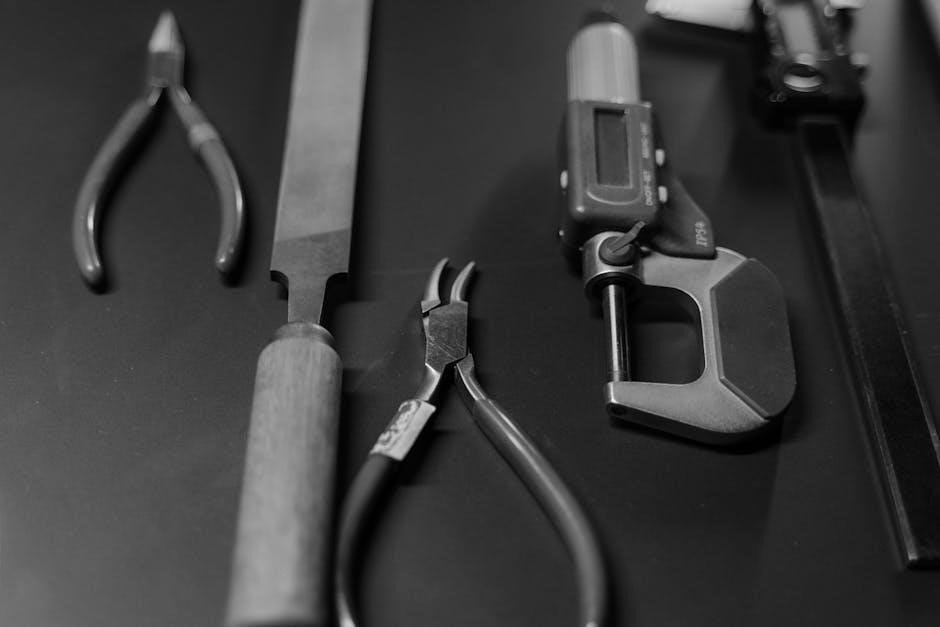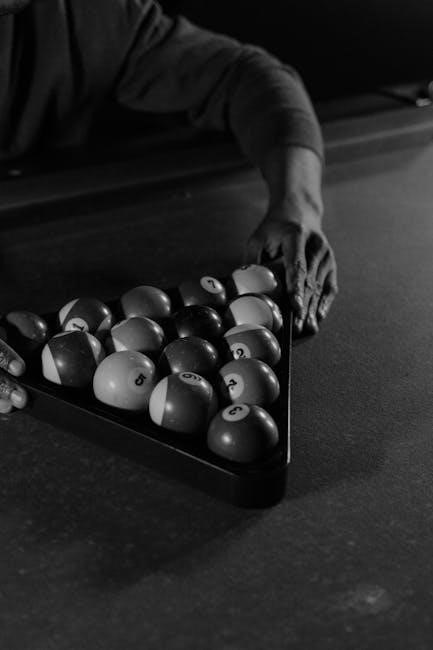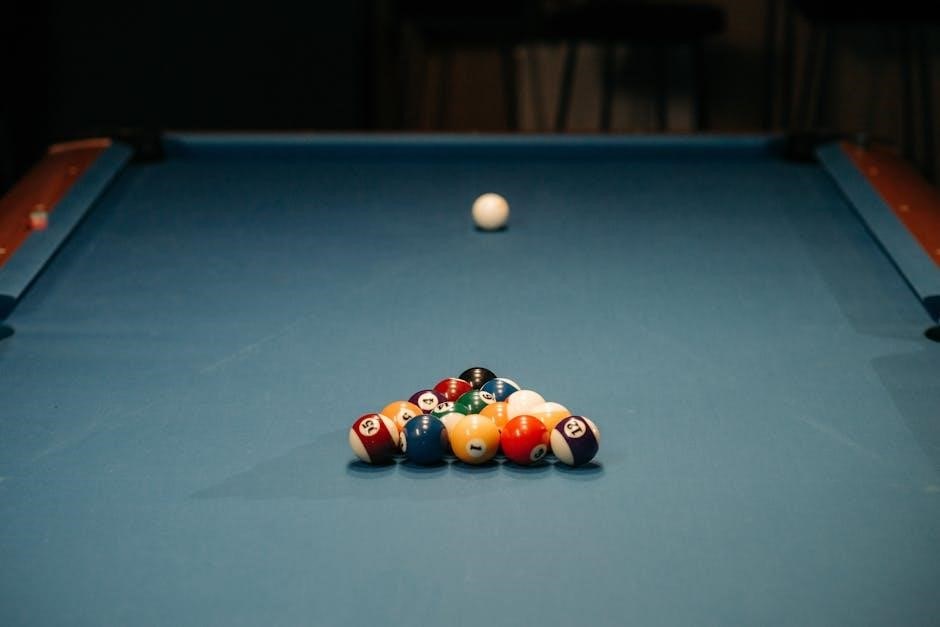Pool Table Assembly: A Comprehensive Guide
Embarking on pool table assembly requires careful attention to detail․ This comprehensive guide navigates you through each stage, from initial unboxing to final leveling․ Safety is paramount, and we emphasize the importance of professional installation due to the weight and complexity involved․ This ensures proper setup and prevents potential damage․
Safety Precautions and Preparation
Prioritizing safety is crucial before beginning any pool table assembly․ Given the substantial weight of the components, always enlist the help of at least two strong adults․ Ensure the assembly area is clear of obstructions and provides ample space to maneuver around the table․ Carefully read all assembly instructions provided in the PDF document in their entirety to familiarize yourself with the process and identify potential hazards․
Wear appropriate safety gear, including gloves to protect your hands from sharp edges and potential splinters․ Eye protection is also recommended to prevent dust or debris from entering your eyes during the process․ Select a well-lit area to ensure clear visibility throughout the assembly․ Consider placing a protective covering, such as the flattened cardboard box, on the floor to prevent scratches or damage to the flooring․
Verify that the intended location of the pool table is suitable, ensuring a level surface to avoid future playing issues․ Remember, attempting to assemble a pool table alone could lead to serious injury or damage to the equipment․ Taking these safety precautions will set the stage for a smooth and secure assembly experience․
Tools and Materials Checklist
Before diving into the assembly process, it’s essential to gather all the necessary tools and materials․ Having everything readily available will streamline the process and prevent frustrating interruptions․ Consult the pool table assembly instructions PDF to confirm the specific tools required for your model, as requirements may vary․
Generally, you will need a Phillips head screwdriver, a flathead screwdriver, and an adjustable wrench․ A socket set can also be beneficial for tightening bolts․ A level is absolutely crucial for ensuring a perfectly flat playing surface․ A staple gun with appropriate staples will be needed for securing the cloth to the slate․ You might want a utility knife for opening packaging and trimming excess cloth․ A measuring tape will help confirm dimensions and placement․
Beyond tools, ensure you have all the necessary hardware included with your pool table, such as bolts, screws, washers, and leg levelers․ A soft cloth can be used to wipe down the table surface and prevent scratches․ A pencil or marker will be helpful for marking locations during the assembly process․ Double-checking your inventory against the parts list in the PDF is crucial before you begin․
Unboxing and Parts Inventory
The first step in assembling your pool table is the careful unboxing and meticulous inventory of all the components․ Locate the pool table assembly instructions PDF and use it as your primary guide․ Choose a spacious, clean area, preferably near the table’s final location, to avoid unnecessary heavy lifting later․ Carefully cut open the packaging, taking care not to damage any of the parts inside․
Remove all components from the box, laying them out in an organized manner․ This allows for easy identification and prevents misplacing any crucial pieces․ Refer to the parts list in the PDF to verify that you have everything accounted for․ Common components include the frame, legs, slate, side and end rails, cloth, pockets, hardware (bolts, screws, washers), and leg levelers․
Pay close attention to the condition of each part․ Check for any signs of damage incurred during shipping, such as scratches, dents, or broken pieces․ If you find any damaged items, contact the manufacturer or retailer immediately to arrange for replacements․ Do not proceed with the assembly until you have all the correct parts in good condition․ Proper inventory now saves headaches later․
Frame Assembly: Attaching the Legs
With the parts inventoried, the next step is assembling the pool table’s frame and attaching the legs․ Refer closely to the assembly instructions PDF, paying specific attention to the diagrams and illustrations related to this stage․ The frame typically consists of several crossbeams and side supports that need to be connected securely․
Begin by laying the frame components on a clean, level surface, often the inside of the box itself to protect the finish․ Connect the crossbeams to the main frame using the provided hardware – usually bolts, screws, and washers․ Ensure all connections are snug but not overtightened at this stage․ Overtightening can strip the threads or damage the wood․

Once the frame is assembled, carefully attach the legs․ The legs are typically attached to the corners of the frame using bolts and washers․ Ensure the legs are oriented correctly, following the instructions in the PDF․ Tighten the bolts securely, but again, avoid overtightening․ With the legs attached, the frame should be able to stand upright, but it’s best to leave it on its side or upside down for now to facilitate further assembly․ Double-check all connections before proceeding․
Installing the Leg Levelers
After the legs are securely attached to the frame, the next crucial step is installing the leg levelers․ These levelers are essential for achieving a perfectly flat playing surface, which is critical for accurate ball roll․ The leg levelers typically screw into threaded inserts located at the bottom of each leg․ Consult your assembly instructions PDF for the specific type of levelers included with your pool table and the recommended installation procedure․

Begin by carefully screwing the levelers into the inserts․ Ensure they are threaded in straight to avoid cross-threading․ Initially, screw them in most of the way, but leave some room for adjustment․ You’ll be making fine-tuning adjustments later in the assembly process․ Once all the levelers are installed, you can carefully stand the pool table upright on its legs․
At this point, it’s important to protect your floor from scratches or damage․ Place protective pads or furniture sliders underneath each leg․ These pads will also make it easier to move the table slightly during the final leveling process․ Once the table is upright and protected, you’re ready to move on to the next stage of assembly․
Attaching the Side and End Rails

With the legs and levelers in place, the next step is attaching the side and end rails, often called aprons․ These rails provide structural support and define the perimeter of the playing surface․ Consult your pool table assembly instructions PDF for the specific attachment method, which usually involves bolts, screws, or brackets․ The rails are critical to the stability of the table and to providing a secure surface for the cushions and cloth later on in the installation process․
Carefully position the side and end rails against the frame․ Ensure the pre-drilled holes align correctly․ If using bolts, insert them through the rails and into the frame, tightening them securely with a wrench․ If screws are used, drive them straight into the frame, avoiding stripping the wood․ The specific assembly is going to depend on the pool table you are putting together․ Take your time to follow the instructions in the assembly guide․
It is important to ensure the rails are flush with the top of the frame․ This will create a smooth, even surface for the slate installation․ After attaching all the rails, double-check the connections and tighten any loose bolts or screws․ The rails should be firmly attached and stable before proceeding․ The end rails and side rails should be aligned correctly․
Slate Installation: Ensuring a Level Playing Surface
The slate is the heart of the pool table, providing the flat, smooth surface essential for accurate gameplay․ This stage demands utmost care, as the slate is heavy and fragile․ Prior to installation, inspect the slate for any cracks or imperfections․ A damaged slate will compromise the table’s performance and require replacement․ Make sure you have at least two people to lift and maneuver the slate pieces․
Carefully lift each slate piece and position it onto the frame․ Align the slate sections according to the markings or guidelines provided in your pool table assembly instructions PDF․ Most tables use multiple slate pieces, so ensure they fit together seamlessly with minimal gaps․ Any unevenness at the joints will affect ball roll․ It is critical to get this stage correct․
Once the slate is in place, use a level to check for any unevenness․ Place the level across different points on the slate surface, including the seams between the pieces․ If any areas are not level, use shims to adjust the height of the slate․ Shims are thin pieces of wood or plastic that can be inserted between the slate and the frame to create a level surface․ Take the time to level the slate correctly, and you will have a much better playing experience․
Securing the Slate to the Frame
With the slate pieces leveled and properly aligned, the next crucial step is securely fastening them to the pool table frame․ This ensures stability and prevents movement during gameplay, which could disrupt the level playing surface․ Typically, this involves using screws to attach the slate to the underlying wooden frame․ The pool table assembly instructions PDF will specify the correct screw type, length, and placement․
Carefully pre-drill pilot holes through the slate and into the frame at the designated locations․ This prevents the slate from cracking or chipping when the screws are inserted․ The pilot holes should be slightly smaller than the diameter of the screws․ Using a power drill with a low torque setting is recommended to avoid over-tightening․ Slowly drive the screws into the pilot holes until they are snug, but not excessively tight․ Over-tightening can damage the slate or strip the screw threads․

Pay close attention to the screw placement around the perimeter of each slate piece and along the seams where the pieces join․ Consistent and secure fastening is essential for maintaining a level and stable playing surface․ After all screws are in place, double-check the slate for any movement or rocking․ If any instability is detected, adjust the screws as needed to ensure a solid and secure connection between the slate and the frame․ Proper installation ensures the stability for years to come!
Cloth Installation: Stretching and Stapling
The cloth installation is a critical step in pool table assembly, directly impacting the playability and aesthetics of the table․ Begin by carefully unrolling the cloth, ensuring it’s free of wrinkles or creases․ Center the cloth over the slate, allowing ample overhang on all sides․ The pool table assembly instructions PDF will usually indicate the correct orientation of the cloth, considering the nap direction․
The key to a smooth, fast playing surface is proper stretching․ Start by securing the cloth at the center of one side with staples, then stretch it tightly across to the opposite side and staple there․ Repeat this process for the other two sides, maintaining consistent tension․ Use specialized cloth stretching tools if available, as these provide even pressure and prevent tearing․ Work your way outwards from the center, gradually stretching and stapling along each edge․
Pay close attention to corners, where the cloth needs to be carefully folded and stapled to avoid bunching or wrinkles․ Use a staple gun with sufficient power to securely fasten the cloth to the wooden frame․ Trim any excess cloth after stapling, leaving a clean edge․ The goal is to achieve a drum-tight surface, free of imperfections․ Take your time, ensuring even tension and a flawless finish for optimal gameplay!
Pocket Installation: Securing the Pockets
Pocket installation is a crucial step in completing your pool table assembly, blending functionality with aesthetics․ Refer to your pool table assembly instructions PDF for specific pocket types and attachment methods, as they can vary․ Typically, pockets are secured using screws, bolts, or staples, depending on the design․ Begin by carefully positioning each pocket within its designated opening in the table’s frame․
Ensure the pocket is flush with the playing surface and aligned correctly before fastening․ For screw or bolt attachments, pre-drilling pilot holes can prevent splitting the wood and ensure a secure fit․ Tighten the fasteners gradually, checking the pocket’s alignment as you go․ Over-tightening can damage the pocket or the frame․ If staples are used, ensure they are driven in straight and flush with the pocket’s surface to avoid snagging balls․
Pay attention to the pocket’s throat, the area where the ball enters․ It should be smooth and free of obstructions․ Some pockets have leather or rubber liners that need to be properly positioned․ Test the pockets by rolling balls into them from various angles to ensure they catch the balls smoothly and reliably․ Make adjustments as needed to achieve optimal ball capture and a professional, finished look․
Final Leveling and Adjustments
Achieving a perfectly level playing surface is the ultimate goal of pool table assembly, ensuring fair and consistent gameplay․ This stage involves meticulous adjustments using a level, ideally a long spirit level, placed across various points on the slate․ Begin by identifying any areas where the table is uneven․ This is where the leg levelers come into play․ Adjust each leveler individually, raising or lowering it until the bubble in the level indicates a perfectly horizontal plane․
Work systematically, starting with one corner and moving around the table, checking the level both lengthwise and widthwise․ Small adjustments can make a significant difference․ After the initial leveling, play a few practice shots to observe ball roll․ Do the balls consistently drift in a particular direction? This indicates a subtle unlevelness that requires further adjustment․ Continue fine-tuning the leg levelers until the balls roll true and straight across the table․
Pay close attention to the seams between the slate pieces, as these can sometimes create slight bumps or dips․ If necessary, use shims placed underneath the slate to compensate for any imperfections․ Remember, patience and precision are key to achieving a professional-quality playing surface․ This final leveling and adjustment stage is what separates a good pool table installation from a great one․
Troubleshooting Common Assembly Issues
Even with meticulous adherence to instructions, pool table assembly can present unexpected challenges․ One common issue is difficulty in aligning the frame components․ This often arises from uneven flooring or slight manufacturing variations․ Loosening the bolts connecting the frame can provide some wiggle room for adjustments․ If the problem persists, shims can be strategically placed between the frame and the legs to compensate for any discrepancies․
Another frequent concern involves the cloth installation․ Wrinkles or bubbles can appear despite careful stretching and stapling․ In such cases, gently remove the staples in the affected area and re-stretch the cloth, ensuring even tension across the surface․ Using a specialized cloth stretching tool can significantly improve the results․ If the slate surfaces are uneven, causing inconsistent ball roll, it may be necessary to consult a professional for slate leveling or shimming․
Pocket installation can also pose problems․ If the pockets are loose or misaligned, check the securing screws or bolts and tighten them accordingly․ Ensure that the pockets are properly seated in their designated openings and that the leather or rubber facings are flush with the playing surface․ Addressing these common issues with patience and attention to detail will ensure a smooth and enjoyable playing experience․
